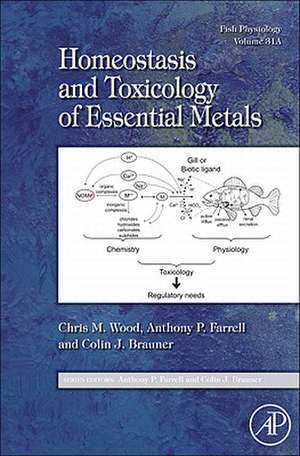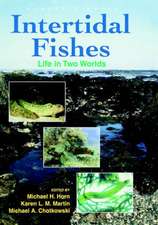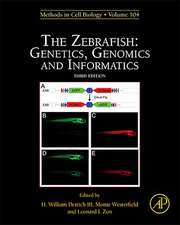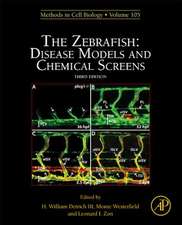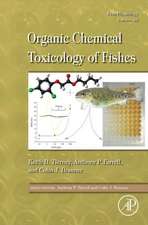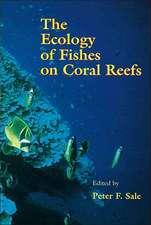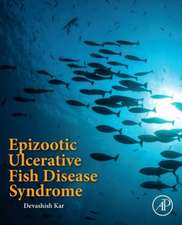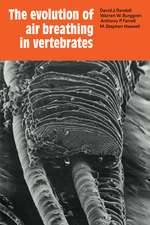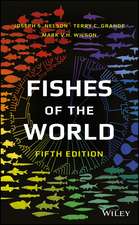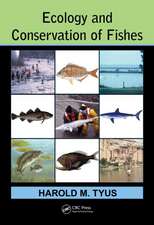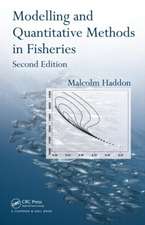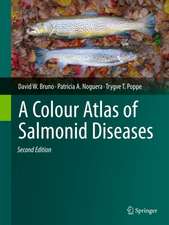Fish Physiology: Homeostasis and Toxicology of Essential Metals: Fish Physiology, cartea 31A
Chris M. Wood, Anthony Farrell, Colin Brauneren Limba Engleză Hardback – 2 sep 2011
The companion volume, Homeostasis and Toxicology of Non-Essential Metals, Volume 31B, covers metals that have no known nutritive function in fish at present, but which are toxic at fairly low levels, such as Ag, Al, Cd, Pb, Hg, As, Sr, and U. In addition, three chapters in Volumes 31A and 31B on Basic Principles (Chapter 1, 31A), Field Studies and Ecological Integration (Chapter 9, 31A) and Modeling the Physiology and Toxicology of Metals (Chapter 9, 31B) act as integrative summaries and make these two volumes a vital set for readers.
- All major essential metals of interest are covered in metal-specific chapters
- Each metal-specific chapter is written by fish physiologists/toxicologists who are recognized authorities for that metal
- A common format is featured throughout this two volume edition
| Toate formatele și edițiile | Preț | Express |
|---|---|---|
| Hardback (2) | 483.18 lei 5-7 săpt. | |
| ELSEVIER SCIENCE – 2 sep 2011 | 483.18 lei 5-7 săpt. | |
| ELSEVIER SCIENCE – 9 sep 2011 | 540.68 lei 5-7 săpt. |
Din seria Fish Physiology
- 27%
 Preț: 969.52 lei
Preț: 969.52 lei - 27%
 Preț: 1156.07 lei
Preț: 1156.07 lei - 38%
 Preț: 593.60 lei
Preț: 593.60 lei - 23%
 Preț: 570.59 lei
Preț: 570.59 lei - 24%
 Preț: 524.58 lei
Preț: 524.58 lei - 18%
 Preț: 522.69 lei
Preț: 522.69 lei - 23%
 Preț: 498.09 lei
Preț: 498.09 lei - 9%
 Preț: 562.99 lei
Preț: 562.99 lei - 31%
 Preț: 495.93 lei
Preț: 495.93 lei - 21%
 Preț: 498.47 lei
Preț: 498.47 lei - 17%
 Preț: 497.35 lei
Preț: 497.35 lei - 27%
 Preț: 557.55 lei
Preț: 557.55 lei - 38%
 Preț: 498.78 lei
Preț: 498.78 lei - 9%
 Preț: 506.27 lei
Preț: 506.27 lei - 11%
 Preț: 665.44 lei
Preț: 665.44 lei
Preț: 483.18 lei
Preț vechi: 525.20 lei
-8% Nou
Puncte Express: 725
Preț estimativ în valută:
92.47€ • 96.18$ • 76.34£
92.47€ • 96.18$ • 76.34£
Carte tipărită la comandă
Livrare economică 05-19 aprilie
Preluare comenzi: 021 569.72.76
Specificații
ISBN-13: 9780123786364
ISBN-10: 0123786363
Pagini: 520
Dimensiuni: 152 x 229 x 25 mm
Greutate: 0.86 kg
Editura: ELSEVIER SCIENCE
Seria Fish Physiology
ISBN-10: 0123786363
Pagini: 520
Dimensiuni: 152 x 229 x 25 mm
Greutate: 0.86 kg
Editura: ELSEVIER SCIENCE
Seria Fish Physiology
Public țintă
Fish physiologists, nutritional physiologists, toxicologists and environmental regulatorsCuprins
Table of Contents
Homeostasis and Toxicology of Essential Metals, Volume 31A
1. An Introduction to Metals in Fish Physiology and Toxicology: Basic Principles / Chris M. Wood
2. Copper / Martin Grosell
3. Zinc / Christer Hogstrand
4. Iron / Nicolas R. Bury, David Boyle, and Christopher. A. Cooper
5. Nickel / Greg Pyle and Patrice Couture
6. Cobalt / Ronny Blust
7. Selenium / David M. Janz
8. Molybdenum and Chromium / Scott D. Reid
9. Field Studies on Metal Accumulation and Effects in Fish / Patrice Couture and Greg Pyle
Homeostasis and Toxicology of Essential Metals, Volume 31A
1. An Introduction to Metals in Fish Physiology and Toxicology: Basic Principles / Chris M. Wood
2. Copper / Martin Grosell
3. Zinc / Christer Hogstrand
4. Iron / Nicolas R. Bury, David Boyle, and Christopher. A. Cooper
5. Nickel / Greg Pyle and Patrice Couture
6. Cobalt / Ronny Blust
7. Selenium / David M. Janz
8. Molybdenum and Chromium / Scott D. Reid
9. Field Studies on Metal Accumulation and Effects in Fish / Patrice Couture and Greg Pyle
Recenzii
"This ‘‘book’’ (actually 2 companion volumes) provides a comprehensive and accessible review of trace metal essentiality, effects of deficiency or excess, homeostatic processes, and toxicology in fishes. The chapters and volumes are constructed with a parallel structure that helps comparisons across the different metals. In addition to the core focus, each chapter includes a brief summary of geochemical speciation, environmental concentrations in natural and polluted areas, environmental quality criteria from different countries, uses, and arguments for and against essentiality. The chapters are all authoritative…These 2 volumes are likely to stand for some time as the defining compendium on the homeostasis and toxicology of metals in fish. The publisher lists them as the First Edition. Perhaps when the Second Edition is written, it will be feasible to expand the scope to include comparative information on aquatic organisms other than fish." --Integrated Environmental Assessment and Management, Volume 8, Number 4, pp. 768-772
